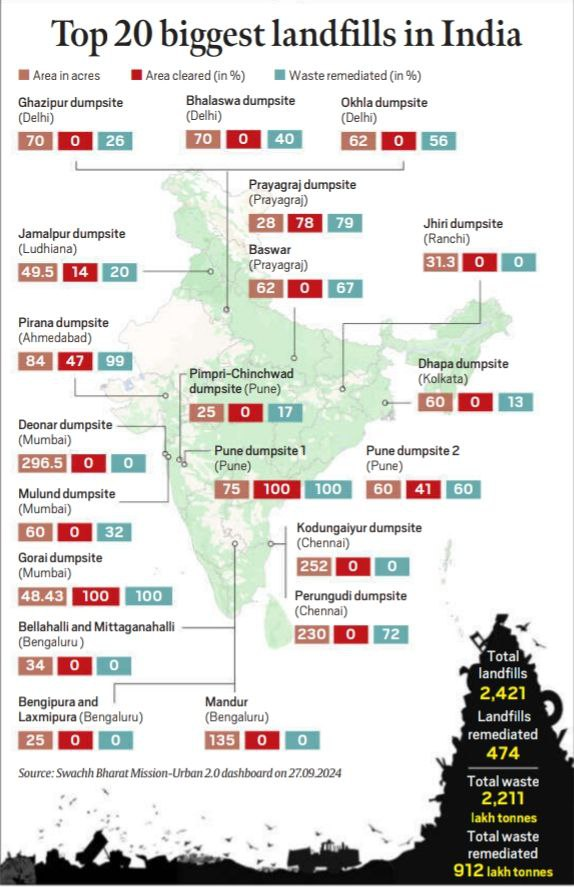Index:
- Swachh Bharat Mission: Status of Landfill Remediation
- Issue of Missing Indians in South-East Asia
- Gold Prices Surge: Geopolitical Conflicts and Economic Factors
- Dark Matter and Neutrino Fog: Latest Developments
- Hezbollah Leader Dead
- A Revolutionary Rice variety
- Mars’ Atmosphere
- 10 Years of Make in India
- Other Headlines of the day
1. Swachh Bharat Mission: Status of Landfill Remediation
- CONTEXT: The Swachh Bharat Mission (SBM) Urban 2.0, launched in 2021, aims to clear 50% of landfills in major cities by 2026. However, as of September 2024, less than half of the work has been completed.
Current Status:
- Only 38% of total waste dumped has been remediated across India.
- Of the 2,421 identified landfill sites, 474 have undergone some level of remediation.
- A total of 912 lakh tonnes of waste has been treated out of the 2,211 lakh tonnes.
Challenges in Clearing Landfills Many cities have failed to start the process of remediating their largest landfill sites, which is leading to delays in meeting the 2026 target.
Waste Generation – India generates approximately 1.17 lakh tonnes of waste per day in urban areas.
Approaches to Landfill Remediation
- Reduction of Dump Height: Many cities like Delhi and Mumbai are reducing the height of landfills to manage waste better.
- Material Recovery: Remediated land is being reused for parks, green areas, and infrastructure.
- Example: Ahmedabad’s Pirana landfill cleared 48% of the waste; land reclaimed is now being converted for community uses.
Reclaimed Land Uses
- Ahmedabad: 43 acres cleared and reclaimed, used for urban parks and roads.
- Chennai (Perungudi): 40% area cleared; similar projects to convert the land into green belts.
- Delhi: Plans to use cleared space for public amenities like sports complexes and parks.
Future Projections
- To meet the 2026 goal, cities will have to clear about 1,717 acres
- The Chandrapur Municipal Corporation (Maharashtra) cleared its entire dumpsite (100%) and now uses the space for public purposes.
Key Challenges
- Large Backlog: A significant amount of waste remains untreated across major cities.
- Delays in initiating landfill remediation work in several urban regions.
- Complexity of Processes: Involving waste sorting, removal, and land reclamation which requires careful planning and execution.
Government Initiatives & Support
- Union Ministry of Housing and Urban Affairs has emphasized the importance of SBM 2.0 and allocated funds for technology-driven remediation.
- Encouragement of public-private partnerships to enhance the pace of landfill clearance.
Focus Areas: Waste-to-energy plants, waste segregation, recycling, and repurposing of remediated lands.
2. Issue of Missing Indians in South-East Asia
- Context: According to Immigration Bureau data (as of May 2024), about 30,000 Indian nationals who travelled to Southeast Asian countries (like Cambodia, Thailand, Myanmar, Vietnam) between January 2022 and May 2024 have not returned.
- Key Concern: These missing individuals raise concerns, especially amid reports of “cyber slavery” and human trafficking involving Indian citizens in Southeast Asia.
Key Data
- Total Travelers: 73,138 Indians travelled to Southeast Asia during this period.
- Number Yet to Return: 29,466 Indian citizens have not returned.
- Over 69% of the missing individuals are linked to Thailand.
- The age group most affected: Majority of the missing individuals are in the 20-39 years age bracket.
Cyber Slavery and Human Trafficking Concerns
- Reports indicate that some Indians have been coerced into cyber slavery—a form of modern slavery where individuals are forced into illegal online activities under threat or coercion.
- These incidents have raised red flags about organized crime networks operating in countries like Cambodia and Thailand.
Government Response
- High-Level Committee: The central government has set up a panel under the Ministry of Home Affairs (MHA) to address this issue.
- The panel has asked all states and Union Territories (UTs) to conduct ground-level verification of the missing individuals.
- Efforts are also being directed towards diplomatic interventions to bring back those trapped in Southeast Asian countries.
Key Recommendations for Policy
- Improved Coordination: Strengthen cooperation between Indian authorities and Southeast Asian nations to track and recover missing citizens.
- Preventive Measures: Raise awareness among potential travelers about the dangers of human trafficking and cyber slavery.
Legal Assistance: Provide legal support and diplomatic assistance to Indians detained or trapped in foreign countries. Stronger Immigration Checks: Enhance immigration protocols and ensure travelers’ safety by keeping track of their return schedules.
3. Gold Prices Surge: Geopolitical Conflicts and Economic Factors
Global Context:
- In 2024, gold prices have surged by 30% internationally, reaching an all-time high.
- In India, the price of gold in Mumbai touched a new peak of ₹75,750 per 10 grams on September 25, 2024.
- Gold futures for October reached an all-time high of ₹76,000 per 10 grams.
Key Factors Driving the Price Surge
- US Federal Reserve Interest Rate Cuts:
- The US Federal Reserve reduced interest rates by 50 basis points (bps), down to the 75-5% range, and signaled further cuts.
- Lower interest rates weaken the US dollar, leading to increased demand for gold as a hedge against economic uncertainty.
- Geopolitical Conflicts:
- Ongoing tensions in the Russia-Ukraine war and the Israel-Hezbollah conflict have pushed up demand for safe-haven assets like gold.
- Investors buy more gold in times of conflict to safeguard wealth against potential market instability.
- Central Bank Actions:
- Central banks have been increasing their gold reserves, particularly due to de-dollarization efforts to reduce dependence on the US dollar.
- Accumulation of gold is also a result of sanctions imposed by Western countries on Russia.
Future Projections – The US Federal Reserve is expected to cut interest rates by an additional 25 basis points in November and December 2024, further supporting gold prices.
De-dollarization Impact: The ongoing global shift to reduce reliance on the US dollar (de-dollarization) by central banks has played a significant role in driving demand for gold.
Correlation between Gold and USD
- Historically, when the US dollar weakens, gold becomes more attractive to investors.
- As the US Federal Reserve continues to lower interest rates and geopolitical risks rise, the demand for gold as a safer investment option increases.
4. Dark Matter and Neutrino Fog: Latest Developments
- Context: Dark matter is a mysterious form of matter that makes up around 85% of the mass in the universe but remains undetected by direct measurement. Despite decades of research, no conclusive detection of dark matter has been made, though recent experiments are coming closer to ruling out certain possibilities.
What is Dark Matter?
- Dark matter constitutes the bulk of the universe’s mass, exerting a gravitational pull that influences galaxies and galaxy clusters. However, it is invisible and does not interact with light or other electromagnetic forces, making it extremely difficult to detect directly.
- Visible Matter: Stars, gas, and planets make up only about 15% of the total mass of the universe.
- Leading Theory: Scientists propose that dark matter may consist of weakly interacting massive particles (WIMPs) or other exotic particles that barely interact with normal matter.
Challenges in Dark Matter Detection
“Neutrino Fog”:
- One of the biggest hurdles in detecting dark matter is the background noise created by other particles, especially neutrinos. Neutrinos are lightweight particles that can pass through matter almost undetected, making it difficult to isolate dark matter signals from these background interactions.
- This “neutrino fog” creates noise that can obscure potential dark matter signals, especially in detectors placed deep underground.
Alternative Avenues for Dark Matter Detection
- Search for Lighter Particles:
- In addition to searching for WIMPs (heavier than atomic nuclei), scientists are also now pursuing the detection of lighter particles that could make up dark matter.
- These lighter particles would interact even more weakly with normal matter, making them much harder to detect but still possible using advanced detectors.
Current State of Dark Matter Research
- Despite the decades of effort and the latest results from the LZ experiment, the scientific community remains committed to pursuing dark matter detection, acknowledging that progress will be incremental.
- Theoretical Implications: Ruling out certain types of dark matter particles helps narrow the field and strengthens the case for alternative hypotheses, including the existence of particles that do not interact with atomic nuclei in conventional ways.











